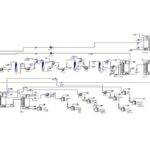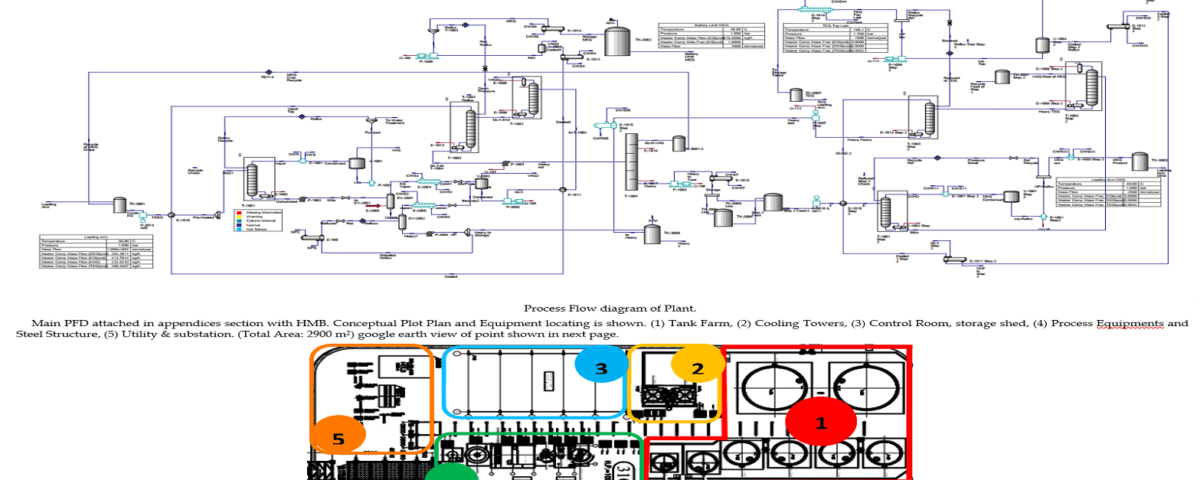Introduction
In the rapidly evolving landscape of the global chemical industry, there is an increasing demand for versatile and essential chemicals, among which Monoethylene Glycol (MEG), Diethylene Glycol (DEG), and Triethylene Glycol (TEG) are significant. Given the rising market needs and the extensive applications of these materials in various industries, this proposal focuses on establishing an advanced production plant capable of efficiently and sustainably producing 15,000 tons of these chemicals annually. The objective of launching this plant is not only to meet domestic needs but also to deliver high-quality products to global markets. By employing modern technologies and sustainable methods, this initiative can enhance the chemical industry and contribute to the economic development of the region.
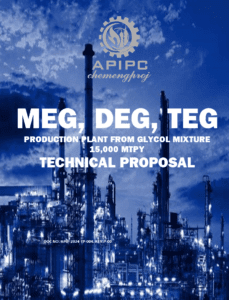
Product Description
– Monoethylene Glycol (MEG): A key component in the textile industry, automotive antifreeze, and polyester production.
– Diethylene Glycol (DEG): Used in the production of unsaturated polyester resins, plasticizers, and in organic syntheses.
– Triethylene Glycol (TEG): Essential for drying natural gas and used in air sanitizers and drying agents.
Project Objective
The goal of establishing an advanced, environmentally responsible, and economically viable production facility is to meet the increasing market demand for MEG, DEG, and TEG.
Feedstock and Product Composition
Understanding the feedstock and product composition is essential for the effective operation of the MEG, DEG, and TEG production plant. This section describes the feedstock composition and the anticipated quantity of each product.
Feedstock Composition
The plant’s feedstock primarily consists of a mixture of MEG, DEG, TEG, water, and various impurities. The exact composition depends on the feedstock source and processing.
Product Quantity
The output of a reaction is defined as the ratio of moles of the desired product formed to the total moles of reactants consumed. It can also be defined as the ratio of moles of the desired product generated to the moles of all products produced, since the moles of all products formed equal the total moles of reactants consumed.
In this production process, the amounts of MEG, DEG, and TEG produced are calculated based on the feedstock composition and the efficiency of the separation and purification processes. Precise values will be determined through simulation and process optimization.
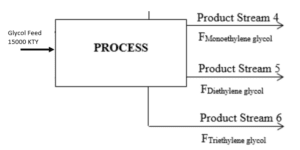
Understanding this feedstock and product quantity is vital for designing process flows, selecting equipment, and optimizing the overall plant efficiency.
Feed Specifications

Utility Requirements

Annual Production

The global chemical industry and the pivotal role of Monoethylene Glycol (MEG), Diethylene Glycol (DEG), and Triethylene Glycol (TEG) in various industrial applications.
– Objective to Establish a Production Facility with a Capacity of 15,000 Tons to Meet the Growing Demand for These Chemicals.
– Emphasis on Sustainable Production Methods and the Importance of These Glycols in the Modern Industrial Landscape.
Product Overview
– Comprehensive Review of MEG, DEG, and TEG, Including Their Chemical Properties, Applications, and Importance in Industry.
– Use of MEG in Textile and Automotive Industries; DEG’s Role in Producing Unsaturated Polyester Resins and Alkyd Resins; TEG Applications in Natural Gas Drying and as a Dryer.
Market Demand
– Growing Market Demand for These Glycols and Their Critical Role in Various Sectors.
– How Establishing This Production Facility Will Address Market Needs and Contribute to Industry Growth.
Sustainability and Environmental Considerations
– Strategies to Reduce Environmental Impacts, Including the Use of Energy-Efficient Processes and Eco-Friendly Materials.
– Compliance with Environmental Regulations and Commitment to Sustainable Production Practices.
Factory Design Principles
This section outlines the fundamental aspects of designing the MEG, DEG, and TEG production plant, including capacity, feedstock, and product specifications.
Capacity
This facility is designed for an annual production of 15,000 tons, focusing on the effective manufacturing of MEG, DEG, and TEG. This capacity aligns with current market demand and future growth forecasts for these products.
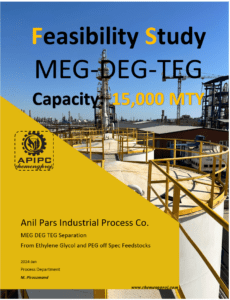
Feedstock
The main feedstock for the plant will be ethylene oxide and water, essential for producing MEG, DEG, and TEG. The feedstock will be sourced responsibly to ensure quality and consistent supply.
Product Specifications
This plant will produce Monoethylene Glycol (MEG), Diethylene Glycol (DEG), and Triethylene Glycol (TEG) at high purity levels suitable for various industrial applications. MEG is primarily used in textile and automotive industries, DEG in resin and plasticizer production, and TEG in natural gas drying.
By-products
The production process may yield some by-products, which will be managed, utilized, or disposed of responsibly.
The design of this plant aims to maximize efficiency, minimize environmental impacts, and conform to the stringent quality standards required by the industry.
Process Description
The process for producing MEG, DEG, and TEG in the proposed plant is designed to be effective and efficient.
Step 1: Absorption and Purification of MEG
In the first step, the collected feedstock, stored in Tank 310-TK-3001, undergoes preliminary treatment. If the feedstock contains lye along with sulfuric acid, it is neutralized. The neutralized feedstock is then transferred using Pump 310-P-3014 A B to Heat Exchanger 310-E-1010. After preheating, the feedstock enters Column 310-T-1001.
In Column 310-T-1001, the water content in the glycol is vaporized. The vaporized water then passes through Condenser 310-E-1001, where it is condensed and directed to Return Drum 310-V-1001. A portion of the distillate product is returned to the column using pump 310-P-1001 A B, while the remainder is sent to Heat Exchanger 310-E-1003 for cooling and then to the water purification unit. The process conditions in Column 310-T-1001 include a vacuum of 250 mbar, created by Vacuum Pump 310-P-6002 A B, and a vapor pressure of 17 barG in Boiler 310-E-1002. The mass return ratio of the column is assumed to be 0.5.
Step 2: Purification of DEG and TEG
The bottom product of Column 310-T-1001 is transferred using Pump 310-P-1002 A B to Evaporator 310-EV-2001. The additional materials from the first stage are processed in Evaporator 310-EV-2002. This step is performed under a vacuum of 25-30 mbar, applied using a three-stage ejector system. The vapors released from the evaporators are condensed in Condensers 310-E-2004 and 310-E-2005 and then cooled to a suitable temperature before being sent to Drum 310-V-2002.
Equipment List
A comprehensive list of equipment is essential for the effective operation of the plant, maintenance planning, safety management, and regulatory compliance in the petrochemical industry. This list includes every piece of equipment uniquely identified with a label or tag, including tag numbers, equipment names, and a brief description. Equipment is categorized based on its function.
– Tanks:
Various tanks and reactors used in the process.
– Pumps:
Different types of pumps for moving liquids through the process.
– Heat Exchangers and Boilers:
Heat exchangers for transferring heat between two or more liquids.
Boilers for generating steam used in the process.
– Columns and Evaporators:
Distillation columns for separating glycol mixtures into MEG, DEG, and TEG.
Evaporators for concentrating glycol solutions.
– Storage Tanks:
Tanks for storing raw materials, intermediates, and final products.
This list is vital in ensuring that all necessary information is readily accessible to personnel working at the facility, facilitating communication and troubleshooting.
ASPEN HYSYS Simulation (Steps 1 and 2)
ASPEN HYSYS, developed by Aspen Technology, is a process simulation software widely used in chemical engineering and process industries for designing, optimizing, and analyzing various processes. This software allows engineers to create detailed process models that represent unit operations and equipment in a virtual environment, simulating the behavior of chemical processes over time.
In this project, version 14 of ASPEN HYSYS was used to simulate the overall process of the production facility. This involved inputting materials and components and then entering the simulation section with the UNIQUAC equation.
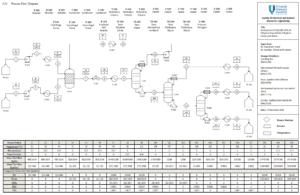
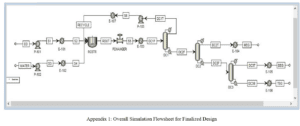
Feed Specifications
The process feed is specified below, with mass percentages in the feed and the corresponding annual flow in tons:
– Monoethylene Glycol (MEG): 55% – 8,300 tons/year
– Diethylene Glycol (DEG): 14% – 2,100 tons/year
– Triethylene Glycol (TEG): 12% – 1,800 tons/year
– Water: 17% – 2,500 tons/year
– Impurities and Heavy Compounds: 2% – 300 tons/year
– Total: 100% – 15,000 tons/year
This simulation is a critical step in validating the process design and ensuring that all parameters are optimized for efficiency and effectiveness. The simulation results aid in understanding the behavior of the plant under various operational scenarios and contribute to decision-making for adjustments and process improvements.
Utilities and General Services
The effective operation of the MEG, DEG, and TEG production plant requires a set of utilities and services categorized for optimal efficiency.
Steam Distribution and Production
High-Pressure Steam (HPS) is transferred from the facility boundaries to the HPS header. This steam is utilized to generate Medium Pressure Steam (MPS) and Low Pressure Steam (LPS). MPS is primarily used for heat exchangers and the steam boilers of columns and is produced by expanding high-pressure steam. LPS is used in the plant for air preheaters, startup heaters for regeneration, service stations, and tracing steam for some lines in winter. This low-pressure steam is produced by the flash evaporation of MP condensate.
Water Treatment
This facility includes an acid water treatment unit and an alkaline water neutralization unit for process water treatment.
Fuel Gas System
This facility includes a fuel gas system to meet various thermal needs within the plant.
Flare System
The plant is equipped with high- and low-pressure flare systems to safely manage excess gases.
Each utility system will have flow diagrams and piping and instrumentation diagrams to provide a clear understanding of operations.
Conclusion
In conclusion, the project to establish a production facility for Monoethylene Glycol (MEG), Diethylene Glycol (DEG), and Triethylene Glycol (TEG) with a capacity of 15,000 tons per year not only responds to the growing market demand but is also designed based on sustainability principles and environmental considerations. By emphasizing energy-efficient production methods and utilizing eco-friendly materials, this plant will contribute to improved product quality and reduced negative environmental impacts. Moreover, with the provision of high-purity products that meet industrial standards, this facility will strengthen market positioning and foster sustainable growth in the chemical industry. Ultimately, this project is significant not only economically but also environmentally in paving the way for a sustainable future in the glycol industry.
To enhance performance and productivity in the design, establishment, production of technical knowledge, innovative engineering, and optimization of glycol production and purification units in Saudi Arabia, Chemengproj Company has undertaken comprehensive simulation and optimization studies on the key processes of this unit. These studies include the following:
1. Feasibility study of the separation and purification unit of glycols with a capacity of 15 KTY.
2. Production of basic engineering documents; Operation Manual for the glycol unit.
3. Performance analysis of production and resource management at the Arta Chemical plant: evaluation of performance reports, human resources, and raw materials.
4. Establishment plan and technical knowledge for producing MEG, DEG, and TEG with a capacity of 15 KTY.
5. Design of documents, technical knowledge, and drawings for BFD, PFD, PID, and UFD of the glycol purification unit.
6. Management, control, and endorsement of engineering documents for the production unit of MEG, DEG, and TEG.
7. Simulation and optimization of the Monoethylene Glycol (MEG) purification process with a production capacity of 10 KTY.
8. Simulation and optimization of the Monoethylene Glycol (MEG) purification process with a production capacity of 15 KTY.
These actions aim to enhance technical knowledge and modern engineering practices, reduce production costs, optimize ethylene glycol production processes, and design updated units. The ultimate goal is to ensure better product quality and increase the company’s competitiveness in the market.
